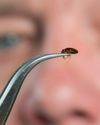
Bed bugs have been around longer than humans. When researchers used bed bug DNA to get an idea of when they first evolved, they found that the ancestors of today's bed bugs were already tiny but successful predators over 115 million years ago, during the reign of the dinosaurs.
What they were preying on back then, we don't know, possibly ancient birds. What we do know is that when the first bats appeared, bed bugs were present. A few enterprising individuals crawled into the caves where bats slept to enjoy a hearty meal. From there, several species of bed bugs evolved to feed on their blood, according to the research of Prof Klaus Reinhardt, an evolutionary biologist at the University of Tübingen, Germany.
As early humans took shelter in those same caves, bed bugs suddenly found they had a larger, juicier mammal to feed on. Somewhere between 900,000 and 100,000 years ago (Reinhardt reckons 245,000 years ago) bed bugs added humans to their roster of victims - a unique move for a parasite, which usually thrive by being highly specialised to one type of host.
The oldest recorded proof of bed bugs that mingled with humans are the 11,000-year-old bugs archaeologists found in caves in North America. There are also fossilised tracks left by bed bug ancestors in ancient Egyptian workers' living quarters from 3,550 years ago, as well as Greek comedy texts from 423 BCE with characters saying.
This story is from the {{IssueName}} edition of {{MagazineName}}.
Start your 7-day Magzter GOLD free trial to access thousands of curated premium stories, and 9,000+ magazines and newspapers.
Already a subscriber ? Sign In
This story is from the {{IssueName}} edition of {{MagazineName}}.
Start your 7-day Magzter GOLD free trial to access thousands of curated premium stories, and 9,000+ magazines and newspapers.
Already a subscriber? Sign In

TAKE IT SLOW
Slow running is a fitness trend with some hard and fast science behind it

Physics, AI and music share a common thread. You just have to know where to look
Studying science can lead you in many directions and open doors to unexpected possibilities along the way

BED BUGS VS THE WORLD
When bloodthirsty bed bugs made headlines for infesting Paris Fashion Week in 2023, it shone a spotlight on a problem that's been making experts itch for decades: the arms race going on between bed bugs and humans

Kids are the key to understanding obesity. But we need more of their genes...
We can unravel the role that bodyweight plays in disease, but we need a bigger, more diverse, sample of genetic material to do so

COVID inquiry: What did we learn and what can we do better in future pandemics?
Masks, social distancing, lockdowns... how effective was the UK's response to the COVID-19 pandemic?

One hormone could be the key that unlocks a cure for morning sickness
The nausea and vomiting that, in extreme cases, can endanger mothers and babies might soon be just a memory

THE WORLD'S WEIRDEST CREATURES
Under the sea and upon the land, some animals look - to us - pretty strange...

WHEN MIND AND MACHINE COLLIDE
First, Elon Musk wanted to make electric cars ubiquitous, then he wanted to make space exploration a private enterprise. Now, with Neuralink, his newest venture, Musk hopes to merge humans and artificial intelligence. Turns out, it might not be such a crazy idea...

COME OUT OF YOUR SHELL
Social anxiety is more than just being shy. It's a phobia born out of our evolutionary past. But that raises a puzzling question: why do so many of us fear human interaction when we're supposed to be the most sociable species on the planet?

SPACE ODDITIES
Take a tour of the weirdest spots in the universe, where the 'normal' rules don't apply. Places that squeeze time, blow bubbles and even rain glass... sideways